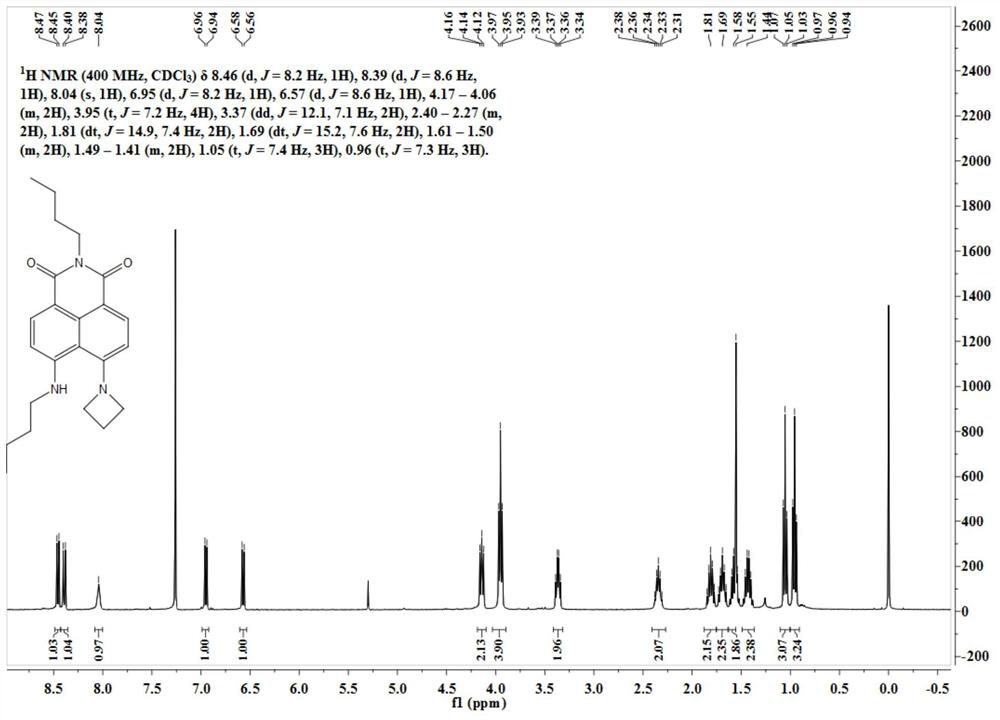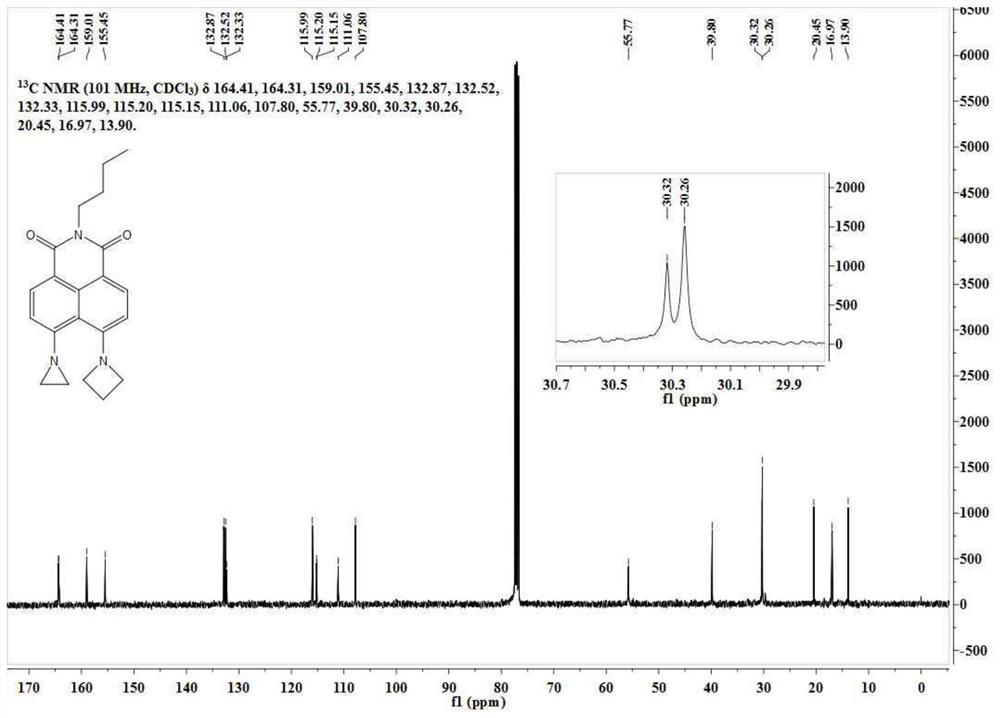A kind of 450nm excited high-brightness, high-stability fluorescent dye and its synthesis method
A high-stability, fluorescent dye technology, applied in the field of fluorescent dyes, can solve problems such as difficult to meet imaging, and achieve the effects of low-cost synthetic raw materials, high fluorescence quantum yield, and high fluorescence brightness
- Summary
- Abstract
- Description
- Claims
- Application Information
AI Technical Summary
Problems solved by technology
Method used
Image
Examples
Embodiment 1
[0040] Synthesis of intermediate N-butyl-4-bromo-5-azetidinyl-1,8-naphthalimide (BuAN-BrAze):
[0041]
[0042] N-butyl-4-bromo-5-nitro-1,8-naphthalimide (100 mg, 0.26 mmol) was dissolved in 10 mL of ethylene glycol methyl ether, and 100 mg of azetidine was added thereto. After the reaction solution was stirred at 50°C for 3 h, ethylene glycol methyl ether was removed under reduced pressure, and the residue was separated through a silica gel column (dichloromethane:methanol=200:1, V / V) to obtain 43 mg of a brown solid with a yield of 42%. Its nuclear magnetic spectrum hydrogen spectrum data are as follows:
[0043] 1 H NMR (400MHz, CDCl 3 )δ8.46(d, J=8.5Hz, 1H), 8.30(d, J=7.9Hz, 1H), 7.82(d, J=7.9Hz, 1H), 6.77(d, J=8.5Hz, 1H) ,4.24(t,J=7.5Hz,4H),4.15(dd,J=10.0,5.0Hz,2H),2.54–2.36(m,2H),1.69(dt,J=15.2,7.6Hz,2H), 1.51–1.35(m,2H),0.96(t,J=7.3Hz,3H).
[0044] Synthesis of BuAN-AzeBu:
[0045]
[0046] BuAN-BrAze (80 mg, 0.21 mmol) was dissolved in 10 mL of ethylene gl...
Embodiment 2
[0050] Synthesis of intermediate N-butyl-4-bromo-5-azetidinyl-1,8-naphthalimide (BuAN-BrAze):
[0051]
[0052] N-butyl-4-bromo-5-nitro-1,8-naphthalimide (100 mg, 0.26 mmol) was dissolved in 2 mL of ethylene glycol methyl ether, and 10 mg of azetidine was added thereto. After the reaction solution was stirred at 70°C for 1 h, ethylene glycol methyl ether was removed under reduced pressure, and the residue was separated through a silica gel column (dichloromethane:methanol=200:1, V / V) to obtain 91 mg of a brown solid with a yield of 89%.
[0053] Synthesis of BuAN-AzeMe:
[0054]
[0055] BuAN-BrAze (100 mg, 0.26 mmol) was dissolved in 2 mL of ethylene glycol methyl ether, and 100 mg of methylamino alcohol solution was added to the reaction solution, and then the reaction solution was slowly heated to 90° C. and reacted for 6 h. Ethylene glycol methyl ether was removed under reduced pressure, and the residue was separated through a silica gel column (dichloromethane:met...
Embodiment 3
[0059] Synthesis of BuAN-AzeAzi:
[0060]
[0061] BuAN-BrAze (50 mg, 0.13 mmol) was dissolved in 10 mL of ethylene glycol methyl ether and 200 mg of aziridine was added to the reaction solution, and then the reaction solution was slowly heated to 120° C. and reacted for 10 h. Ethylene glycol methyl ether was removed under reduced pressure, and the residue was separated through a silica gel column (dichloromethane:methanol=100:1, V / V) to obtain 22 mg of a dark yellow solid with a yield of 47%. The NMR spectrum and carbon spectrum of the BuAN-AzeBu prepared in embodiment 3 are as follows: figure 2 , image 3 As shown, the specific data are:
[0062] 1 H NMR (400MHz, CDCl 3 )δ8.43(d, J=5.9Hz, 1H), 8.41(d, J=6.3Hz, 1H), 7.02(d, J=8.1Hz, 1H), 6.53(d, J=8.5Hz, 1H) ,4.28–4.08(m,6H),2.38(dt,J=15.0,7.5Hz,2H),2.26(s,4H),1.68(dt,J=15.2,7.6Hz,2H),1.43(dq,J =14.7,7.3Hz,2H),0.95(t,J=7.3Hz,3H). 13 C NMR (101MHz, CDCl 3 )δ164.41,164.31,159.01,155.45,132.87,132.52,132.33,115.99,11...
PUM
 Login to View More
Login to View More Abstract
Description
Claims
Application Information
 Login to View More
Login to View More - R&D
- Intellectual Property
- Life Sciences
- Materials
- Tech Scout
- Unparalleled Data Quality
- Higher Quality Content
- 60% Fewer Hallucinations
Browse by: Latest US Patents, China's latest patents, Technical Efficacy Thesaurus, Application Domain, Technology Topic, Popular Technical Reports.
© 2025 PatSnap. All rights reserved.Legal|Privacy policy|Modern Slavery Act Transparency Statement|Sitemap|About US| Contact US: help@patsnap.com



